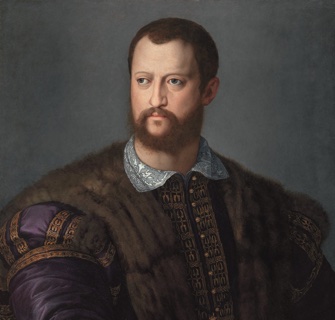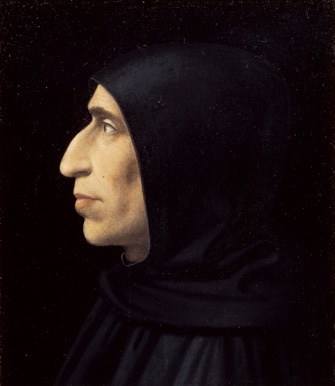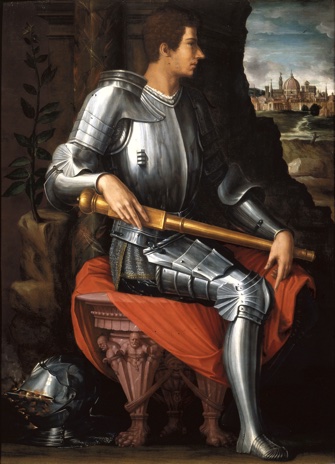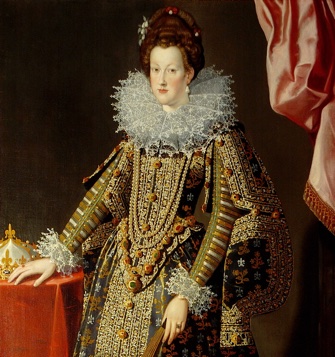Picturing the Medici:
Power Personified

“Portrait of Cosimo I De’Medici” (1560), by Bronzino. © The Alana Collection, Newark, Delaware, USA.
The year is 1530, the setting is the Florentine court: the scene is set for the return of one of Italy’s most powerful dynastic families. The exhibition “Florence, Portraits at the Court of the Medici,” currently on show at the Musée Jacquemart-André, reveals a multitude of characters, a battlefield of hierarchies and a world of intrigue, romance and extravagance.
During the Renaissance, the art of individualized portraiture began sweeping across Europe, providing an opportunity to represent the subjects’ personal characteristics, social status and dynastic connections.
The genre took aristocratic society by storm. Florence, a cultural epicenter of 16th-century Europe by virtue of its wealthy residents and lavish patrons, was the stage for some of the finest portraiture of the time.
The exhibition presents around 40 pieces from the 16th century, with works by some of the greatest portrait painters of all time, among them Rosso Fiorentino, Andrea del Sarto, and Agnolo Bronzino, who were almost as well-known as the upper-class personalities they were commissioned to paint. The focus is on the Medici dynasty, which was at the pinnacle of its power in the 1500s. The paintings, which trace the evolution of cinquecento portraiture, are arranged thematically: court, heroic, allegorical and ceremonial portraits.
The century began with an austere style reflecting the regime of the fanatical reformer Savonarola, who presided over a “Bonfire of

“Portrait de Savonarola” (1498-99), by Fra’ Bartolomeo © S.S.P.S.A.E e per il Polo Museale della Città di Firenze
the Vanities” in 1497, during which “indecent” literature, clothing and art, particularly nude statues, were reduced to ash. One example of this style is the ebony-black clad maiden in Ridolfo del Ghirlandaio’s “Dame au Voile” (1510-15), who gazes down detachedly on visitors with a grave expression while clutching a prayer book to her chest.
The return of the Medici dynasty by armed coup in 1530 after a popular revolt that had briefly sent them into exile did away with that austerity. The paintings in the subsequent section demonstrate how the Medici used portraiture as a means of propaganda to win over the Florentine population by stressing their noble qualities, military might and fantastic wealth.
In Vasari’s 1534 “Portrait d’Alexandre de Médicis devant la Ville de Florence,” for example, the subject cuts a heroic figure. Clad

“Portrait d’Alexandre de Médicis devant la ville de Florence” (c. 1534), by Giorgio Vasari © S.S.P.S.A.E. e per il Polo Museale della Città di Firenze
in full armor and draped in red cloth symbolizing the blood spilt during the Medici siege of Florence, Alessandro, the city’s youthful ruler, is depicted gazing proudly over the newly conquered town. His sovereign right is evoked by the gold staff of power he clutches in his hand, while in the background a laurel branch emerges from the trunk of a dead tree – a metaphor for the rebirth of a dynasty.
The exhibition goes on to portray the move toward a more allegorical style between 1560 and the end of the century, with references to literary figures, music and folklore, and the illustration of such sentiments as love and familial affection. These are especially noticeable in the exhibition’s series of children’s portraits by Santi di Tito.
The movement during this period of the Renaissance back to ancient ideals of beauty, learning and friendship is reflected in a classical style with graceful, serpentine curves, noble angularity and elongated forms. Mirabello Cavalori’s “Portrait d’un Jeune Homme comme Allégorie de l’Amitié,” painted after 1565, is typical of this trend. A young male figure is portrayed with the archetypal, idealistic beauty of classical art and is meant to represent the epitome of the sentiment of friendship. The image abounds with symbolism: the dog by the man’s side represents loyalty; the double columns acts as an image of harmony; and a bas-relief of Achilles lamenting the death of Patroclus, his brother-in-arms, evokes the timeless nature of amity. The youth’s open cloak reveals a scarlet heart etched with the motto “far and near,” while other inscriptions in the painting present the concepts of death and life and winter and spring – each a perfectly balanced pair, each as reliant on one as the other.
The influence of Mannerism on the portrait is explored through depictions of poets and musicians (don’t miss the fascinating excerpt of the film “Les Mains Maniéristes,” in which Hector Obalk explores the way three Mannerist painters, Correggio, Del Sarto and Bronzino, painted hands).
This show, as rich in masterpieces as the Medici were in florins, ends fittingly with a portrait of Maria de’ Medici, in all her

“Portrait de Marie de Médicis” (detail, 1600), by Santi di Tito and studio. © S.S.P.S.A.E. e per il Polo Museale della Città di Firenze
splendor, wearing a heavily bejeweled gown as the new queen of France in 1600. As the second female member of the banking dynasty (Catherine de’ Medici was the first) to make the leap to royal status, she represented the achievement of the aspirations hinted at in all these regal portraits of the clan.
Musée Jacquemart-Andre: 158, boulevard Haussmann, 75008 Paris. Métro: Miromesnil. Tel.: 01 45 62 11 59. Open daily, 10am-6pm, until 8:30pm on Monday. Admission: €12. Through January 25, 2016. www.musee-jacquemart-andre.com
Reader reaction: Click here to respond to this article (your response may be published on this page and is subject to editing).
Please support Paris Update by ordering books from Paris Update’s Amazon store at no extra cost. Click on your preferred Amazon location: U.K., France, U.S.
More reviews of Paris art shows.
© 2015 Paris Update
Favorite